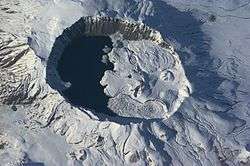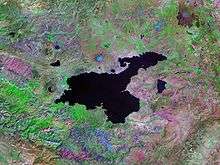Lake Nemrut
Lake Nemrut (Turkish: Nemrut Gölü) is a freshwater crater lake in Bitlis Province, eastern Turkey. It is part of Nemrut Caldera (Turkish: Nemrut Kalderası), a volcanic caldera atop Volcano Nemrut. The caldera is a registered natural monument and the wetlandsis registered as a Ramsar site of the country.
| Lake Nemrut | |
|---|---|
| Nemrut Caldera (Nemrut Kalderası) | |
 Satellite view (2001) | |
 Lake Nemrut Location of Lake Nemrut in Turkey. | |
| Location | Bitlis Province, Turkey |
| Coordinates | 38°38′16″N 42°14′19″E |
| Lake type | Crater |
| Native name | Nemrut Gölü |
| Basin countries | Turkey |
| Max. length | 4.9 km (3.0 mi) |
| Max. width | 2.1 km (1.3 mi) |
| Surface area | 12.36 km2 (4.77 sq mi) |
| Average depth | 140 m (460 ft) |
| Max. depth | 176 m (577 ft) |
| Surface elevation | 2,247 m (7,372 ft) |
| References | [1] |
| Official name | Nemrut Caldera |
| Designated | 17 April 2013 |
| Reference no. | 2145[2] |

Caldera
The caldera is located west of Lake Van in the Tatvan, Ahlat and Güroymak districts of Bitlis Province. It is named after the biblical figure King Nimrod. The caldera is 13 km (8.1 mi) far from Tatvan, and 25 km (16 mi) from Ahlat. With its width of nearly 10 km (6.2 mi), the crater of Nemrut Volcano is one of the largest calderas of the world. The western half of the crater is covered by the lake. At the summit, there are five lakes, two of them existing permanently and the others seasonal. The biggest of the lakes is Lake Nemrut in the form of crescent. It contains freshwater of colorless, odorless and drink water quality.[3]
Lake Nemrut is situated at an elevation of about 2,247 m (7,372 ft) above main sea level. It has an area of 12.36 km2 (4.77 sq mi), and its average depth is about 100 m (330 ft) with a maximum depth of 176 m (577 ft).[3]
Nemrut Caldera is on the youngest volcanic cone in Turkey, which is in a not-eroded state. This unique structural geomorphology make it a subject of scientific research.[3]
Biota
Flora
About 450 plant species were recorded in and around Nemrut Caldera, around 200 (44%) of them belonging to the region. The diversity of the flora points out to the variation of climate conditions in the past. Around 38 (8.4%) of the existing plant species are endemic. The upside down tulip, which grows here, is a world-famous flower. The climax vegetation of Nemrut Caldera forms the haired birch (Betula) and the trembling aspen (Populus tremula). Other notable plants growing around two lakes of the caldera are the trees dwarf juniper (Juniperus communis), Norway maple (Acer platanoides), European mountain ash (Sorbus aucuparia), common buckthorn (Rhamnus cathartica), sessile oak (Quercus petraea), pedunculate oak (Quercus robur), white willow (Salix alba), and the shrubs coinwort cotoneaster (Cotoneaster nummularius), cherry plum (Prunus divaricata), grey willow (Salix cinerea), Greek juniper (Juniperus excelsa), breaking buckthorn (Frangula alnus), alder buckthorn (Frangula alnus) and mahaleb cherry (Prunus mahaleb). Steppe-like vegetation is spread over wide areas in the caldera. Those are mainly species of milkvetch (Astragalus). Other subshrubs and herbaceous plants are prickly thrift (Acantholimon), sainfoin (Onobrychis), sheep's sorrel (Rumex acetosella), Thymus, Alyssum, sheep's fescue (Festuca ovina), Salvia, Ranunculus, Silene, rabbitfoot clover (Trifolium arvense), Pimpinella, Artemisia, squarrose (Centaurea triumfettii). Reedy areas are present In the northwestern part of Lake Nemrıt.[3]
Fauna
The griffon vulture brood their eggs at the caldera, which earned its status of special protected area as habitat for breeding of velvet duck and golden eagle. The number of bird species decreased at Lake Nemrut, which is a stopover site for a lot of migrating birds, due to irregular and uncontrolled hunting. Currently observed animals in the region are the bird species partridge, duck, bee-eater, Armenian gull and mammals hare, fox, bear. The chamois has been extinct.[3]
Natural monument and Ramsar site
The caldera was registered a natural monument in 2003. The protected area around the crater lake covers 4.8 km2 (1.9 sq mi).[4] Nemrut Caldera Natural Monument (Turkish: Nemrut Kalderası Tabiat Anıtı) is protected in the status of a tourist attraction, a protected area of first degree and a wetland.[3]
The government of Turkey designated the wetland of the caldera as the 14th Ramsar site of the country on April 17, 2013.[3][5][6][7]
It is not permitted to cut reed in the caldera and to fish in the lake, although some livestock grazing takes place around the caldera. A winter sports and ski center was established on the southern slope of the caldera in 2007. The main threat in terms of ecology is overgrazing.[3][6]
References
- Özpeker I. Nemrut Yanardağinin petrojenezi // Ofset Baski Atölyesi, ITÜ Maden Fak., № 3/14, 1973
- "Nemrut Caldera". Ramsar Sites Information Service. Retrieved 25 April 2018.
- "Nemrut Krater Gölü – Bitlis" (in Turkish). Türkiye Sulak Alanlar. Retrieved 2017-01-28.
- "Türkiye'nin Tabiat Anıtları" (PDF) (in Turkish). Milli Parklar. Archived from the original (PDF) on 2016-04-20. Retrieved 2017-01-27.
- "urkey's Important Wetlands – Ramar Sites" (PDF). Türkiye Sulak Alanları. Retrieved 2017-01-29.
- "Turkey designates a unique volcano caldera". Ramsar Convention Wertlands. 2013-05-04. Archived from the original on 2017-02-02. Retrieved 2017-01-29.
- "Turkey – Nemrut Caldera". Ramsar. Retrieved 2017-01-29.
External links
| Wikimedia Commons has media related to Lake Nemrut. |
